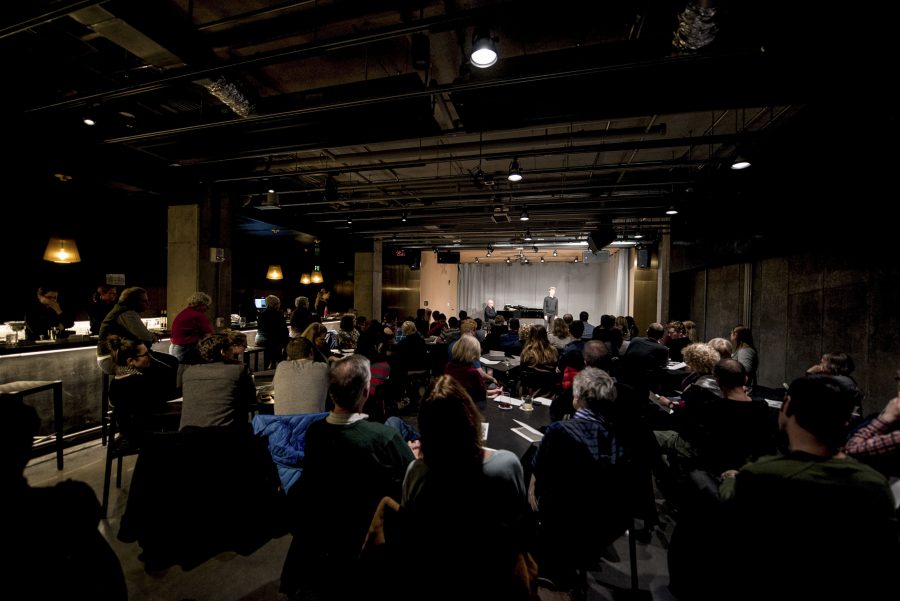Birenbaum Performance Space Opens in Hotel
Photo courtesy of Yevhen Gulenko
Audience members attend a performance at the Birenbaum Innovation and Performance Space, a new venue for concerts and classes that opened Jan. 23 at the Peter B. Lewis Gateway Center.
February 10, 2017
Dozens of students, faculty and community members descended upon the new Peter B. Lewis Gateway Center to attend the Jan. 23 inaugural concert in the Birenbaum Innovation and Performance Space, the experimental new venue on campus. The intimate, modern space occupies a subterranean room filled with sleek, geometric tables and chairs, a bar, a stage and a Steinway piano, where students in the Winter Term Chamber Music Intensive gave their showcase performance.
The showcase, comprised of performances from students in the Winter Term Chamber Music Intensive, was the first in what the College hopes will be a long tradition of creative performance in the new space.
The jazz club-like space is intended to bring together different faces of the Oberlin community, including College and Conservatory students, faculty and community members. As of now, the room will be managed by the Conservatory production office, although the Gateway Center will be in charge of the bar and hospitality services.
The unique flexibility of the room — which can be transformed from a classroom into a club in a matter of minutes — is designed for functional versatility. During the school day, the room will be used for Oberlin’s entrepreneurship classes and as a space for student collaboration. At night, the room will open up into a performance space that emphasizes the role of audience engagement and creativity.
Performers won’t be able to ignore their audience — as they might in a more traditional concert hall — in a place like this, designed to provide opportunities for performative experimentation in less formal settings, rather than another immaculate stage for entertaining a silent, focused audience.
“We want our students to have a chance to engage a different audience and to engage with the audience in a different way,” said Andrea Kalyn, dean of the Conservatory, “If there’s a bar and [the audience] is sitting at tables and they’re chatting, that’s a different kind of experience for performers.”
Oberlin already has a number of performance spaces on campus, but none that directly link the goals of the entire institution together, according to Kalyn.
“There are things that you can get away with in [the Birenbaum] that maybe seem a little too risky in Kulas,” Kalyn said. “We really needed something that put out the entire nature of Oberlin: a place of experimentation, a place of impact, a place of community coming together, and a place of work at the highest level.”
Events planned for the space include orientation events, Oberlin’s LaunchU meeting in March, jazz performances, the Contemporary Music Ensemble, Sinfonietta and various student and guest recitals. The possibilities are wide open.
“Playing in the Birenbaum was a lot of fun. I love how the space has the potential to accommodate such a wide variety of experiences,” double-degree sophomore Nicholas Gallitano, a violist in the Winter Term Chamber Music Intensive, wrote in an email to the Review.
Still, the ambitious mission of the Birenbaum might fall short when it comes to the acoustics in the space, as initial student performances in the space have been met with mixed reviews.
For junior Viola Performance major Jude Park, another member of the Chamber Intensive, the space was difficult to perform in due to its exceptionally dry acoustics, particularly when performing chamber music.
“You essentially have to produce your own resonance and trust your instincts to play together,” Park said.
Despite these challenges, Park added that performing at the Birenbaum — so different from Kulas Recital Hall — is still an educational experience.
“I do believe the Birenbaum has a lot to offer,” Park said. “It’s an intimate place in which Conservatory students can learn how to interact with music in spaces we’re not used to.”
The administration hopes that the real-world implications of the project will be wide-reaching. While it can be hard to escape the Oberlin bubble, the new space can provide performers with a small taste of the world beyond Oberlin.
“We want you to imagine what your lives are going to be like after Oberlin,” Kalyn said. “How does this [Oberlin] education live on, how does it have an impact, how does it create change and how does it create value in the world? … You should be practicing that while you’re students. [This] is a space that you can practice this in.”
The Birenbaum will also provide a different kind of experience than many Oberlin audience members are accustomed to, its casual modernity drawing people in from across the community — especially those who enjoy their live music with refreshments.
“The environment of the Birenbaum is contemporary, hip … and just intimate enough to provide a terrific ‘alternative’ environment to bring people together for great music,” Coordinator of the String Chamber Music at Oberlin Merry Peckham, who attended the Winter Term Chamber Music Intensive’s performance in the space, wrote in an email to the Review. “I look forward to one day experiencing more great chamber music at the Birenbaum while enjoying whatever beverage might be appropriate for the ‘vibe’ of the repertoire being performed. A glass of Chardonnay with Mozart? A martini with Ravel? A beer with Brahms? Who knows?”




















